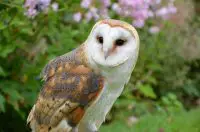Barn owl (Tyto alba) is a medium-sized owl. It has a mottled appearance of grayish-brown color with long wings. Its facial disc is shaped like a heart and its beak is yellowish-brown in color. It is not a migratory bird. Barn owl is a nocturnal (active during night) bird just like many other owls. It does not hoot but makes a ‘shree’ kind of a sound. Whenever it senses the danger, it makes snake-like ‘hissing’ and ‘clicking’ sounds.
It can grow to a length of 33 to 39 centimeters and weighs around 224 to 710 grams. It has a wingspan of 80 to 95 centimeters.
Barn owls tend to live longer in captivity and have a lifespan of about 20 years. However, the mean lifespan of these owls is just about 4 years.
Fema le barn owls breed at the age of 10 to 11 months. Mating season of barn owls starts from March to June in North America and Europe. However, those barn owls that inhabit tropical regions do not have any specific time for breeding.
le barn owls breed at the age of 10 to 11 months. Mating season of barn owls starts from March to June in North America and Europe. However, those barn owls that inhabit tropical regions do not have any specific time for breeding.
The size of its clutch (group of eggs) can range from 4 to 7 eggs. The eggs are incubated for about 30 days.
It is the most wide-ranging bird and it is found all the over the world except Antarctica.
Barn owl inhabits farmlands, ponds, rough grass and terrain. It nests in fissures of old buildings, rock outcrops, cliff and trees. It roosts at an altitude of about 6,600 feet.
Barn owl prefers to feed on rats, voles, shrews and mice. But they also eat other small animals like lizards and amphibians. Every night, it eats 4 small mammals on average.
The loss of grassland due to urbanization and development are the main causes of decline in the population of barn owl.
Common raccoon, eagle, hawks and large American opossums are the predators of these owls.
Other name: Common Barn Owl





